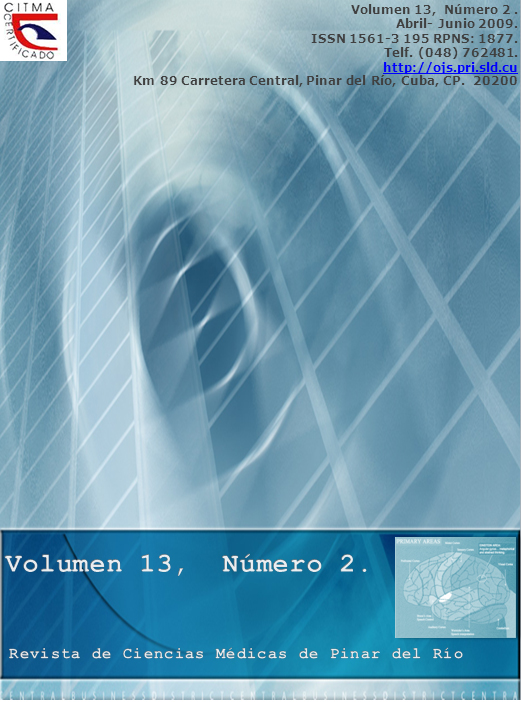Las periodontopatías como factor de riesgo de la cardiopatía isquémica, 2008 / Periodontopathies as a risk factor for ischemic heart failure, 2008
Abstract
Se realizó una investigación descriptiva, longitudinal y prospectiva, con una muestra constituida por 120 pacientes, pertenecientes al área de salud Turcios Lima y atendidos en la Clínica Estomatológica "Guamá", del municipio Pinar del Río, durante el año 2008, con el objetivo de determinar la relación entre la enfermedad periodontal y la cardiopatía isquémica. Los pacientes fueron divididos en dos grupos etarios: grupo A(Control) integrado por 60 pacientes escogidos aleatoriamente que asistían a nuestra consulta y sin historia de infarto agudo del miocardio, y el grupo B (pacientes infartados) de 60 pacientes que fueron remitidos desde los consultorios médicos para ser incluidos en esta investigación. Al total se aplicó el índice de necesidad de tratamiento periodontal de la comunidad. Todos los pacientes infartados grupo B sufrieron periodontopatías, mientras que entre los no infartados solo la mitad padecieron de afecciones parodontales. Se utilizaron los métodos de la Estadísticos descriptiva y la comparación de frecuencias de Ji cuadrado al 95 % de certeza. El hábito de fumar, la edad mayor de 50 años, el sexo masculino y la mala higiene bucal se identificaron como factores comunes de riesgo para ambas enfermedades. Los estadios más avanzados de la enfermedad periodontal (bolsas de 6 mm o más), aumentaron su incidencia con la edad y fue más frecuente en los pacientes infartados, con mayor necesidad de cirugía periodontal. Todos los pacientes afectados tenían necesidad de adiestramiento en cepillado dental.
Palabras clave: ENFERMEDAD PERIODONTAL / epidemiología, CARDIOPATIA ISQUEMICA / epidemiología / factores de riesgo.
ABSTRACT
A descriptive, longitudinal and prospective research was conducted with a sample of 120 patients belonging to the primary care health area of "Turcios Lima" Outpatient Clinic attending to "Guama" Dentist's Clinic in Pinar del Rio municipality during 2008, and was aimed at determining the relation between periodontal diseases and ischemic heart failure. The patients were divided into two groups: A (control) comprised of 60 patients randomly chosen from those attended to the dentist office without medical history of acute myocardial infarction, and group B- (patients who suffered from infarction) 60 patients referred from the family medical office. The total of the sample was examined and the rate of need for periodontal treatment of the community was applied. Descriptive statistic methods were used, and Ji squared test for 95 % of certainty was used to compare frequencies. All patients of the group-B suffered from periodontopathies, meanwhile those belonging to group-A only the half of them suffered from parodontal affections. The smoking habit, over 50 years, male sex and poor oral hygiene were identified as common risk factors for both diseases. The most advanced stages for periodontal disease (bursas of 6mm or more) increased with age being more frequent in patients of group-B having a greater need of periodontal surgery. All the patients affected had to be trained in teeth brushing.
Key words: Periodontal disease/epidemiology, Ischemic heart failure/epidemiology/risk factors.
Downloads
References
1- Carranza F A. Periodontología clínica de Glickman. 7ª ed. México: Editorial Interamericana; 2008.
2- Bagan J V. El manual de odontología. España: Masson Alvad; 2006.
3- Bennett y Plum. Texto complementario del tratamiento de medicina interna del Cecil. Tomo I, 20a ed. Editorial Ciencias Médicas. Cuba; 1996.
4- Dorado C. Periodontopatías. Tratamientos locales. Revista Europea de Odonto _ Estomatología. 2009; IX (5): p.25-36.
5- Contreras A, Slots J. Factores de riesgo en la enfermedad periodontal. J Periodont Rev. 2007; 35:3 _ 16.
6- Charles K F. Enfermedades del corazón, 3 era ed. México: Editorial Interamericana; 2006.
7- Page R C. Risk assessment for periodontal disease. Int Dent J. 2006; 47: 61-87.
8- Adams KF. "Clinical definition and epidemiology of acute myocardial infarction". Am Herat J. 2008; 135(6 Suppl):204.
9- Albert JS. Manual de diagnóstico y terapéutica cardiovasculares, 2 ed.
Barcelona: Masson Salvat; 2007.p. 213 _ 218.
10 _ Bascones A. Tratado de odontología. Tomo III. Madrid: Editorial Trigo S.A; 1998.
11 _ Lindhe J. Periodontologìa clínica. 2 da ed. Buenos Aires: Editorial Médica Panamericana; 2007.
12 _ Buchanan Rally A. Calculus removal by scaling root planning with and without surgical access. J Periodontol. 2008; 58: 159 - 163.
How to Cite
Issue
Section
License
Authors who have publications with this journal agree to the following terms: Authors will retain their copyrights and grant the journal the right of first publication of their work, which will be publication of their work, which will be simultaneously subject to the Creative Commons Attribution License (CC-BY-NC 4.0) that allows third parties to share the work as long as its author and first publication in this journal are indicated.
Authors may adopt other non-exclusive license agreements for distribution of the published version of the work (e.g.: deposit it in an institutional telematic archive or publish it in a volume). Likewise, and according to the recommendations of the Medical Sciences Editorial (ECIMED), authors must declare in each article their contribution according to the CRediT taxonomy (contributor roles). This taxonomy includes 14 roles, which can be used to represent the tasks typically performed by contributors in scientific academic production. It should be consulted in monograph) whenever initial publication in this journal is indicated. Authors are allowed and encouraged to disseminate their work through the Internet (e.g., in institutional telematic archives or on their web page) before and during the submission process, which may produce interesting exchanges and increase citations of the published work. (See The effect of open access). https://casrai.org/credit/



